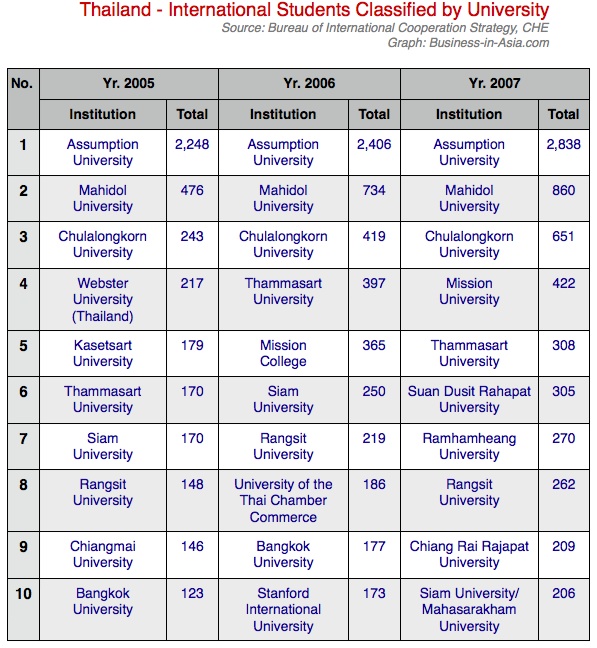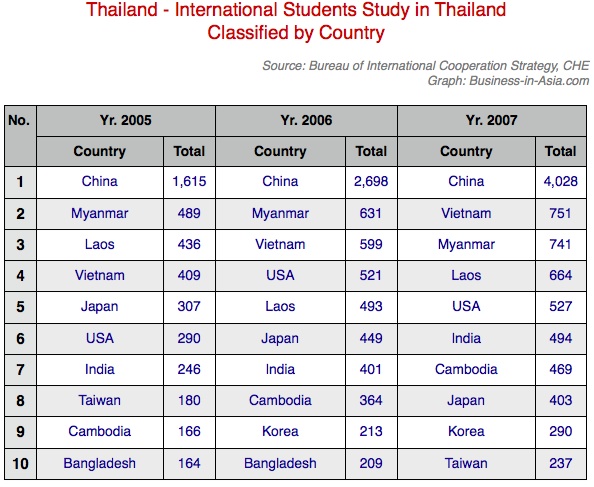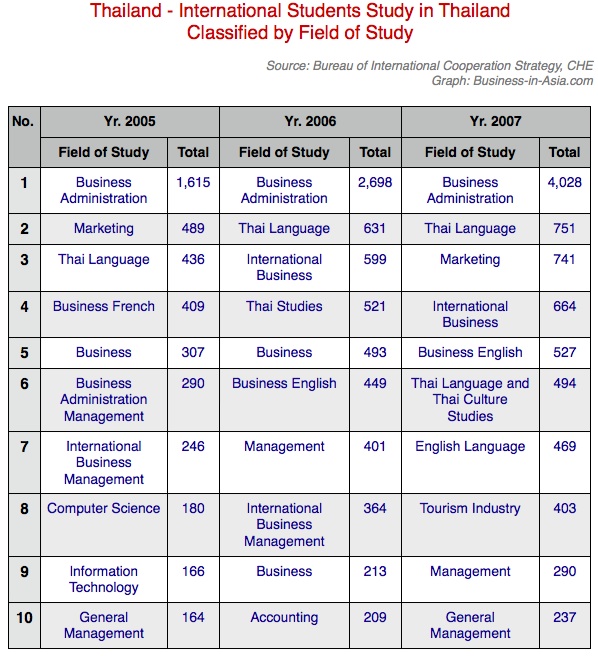The first university in Thailand,
Chulalongkorn University, was established in 1917. This was
done by bringing together the School of Civil Servants, the Royal
Medical College and the Engineering School. In the time since
this fairly early start for the region, higher education in Thailand
has grown considerably. As of July, 2008, there were 164 higher
education institutions under the supervision of the Commission on
Higher Education, Ministry of Higher Education. Of these 164
institutions, 78 were public, 67 were private and 19 were cmmunity
colleges. Please see table below:
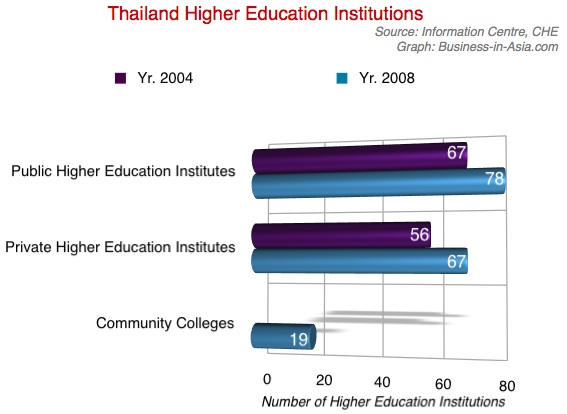
|
One thing to note here is that there
are higher education institutions
under other ministries as well so that the total number is actually
much larger. For example, the Institute of Physical Education has
17 campuses and is under the Ministry of Tourism and Sports.
Additionally there are 29 nursing colleges and 7 public health colleges
under the Ministry of Public Health and finally 12 dramatic arts
colleges and 3 fine arts colleges under the Ministry of Culture.
Management
The Ministry of Education oversees all aspects of education from
pre-school through upper secondary school and some higher education
programs (e.g. teacher training and technical and vocational
education). Private primary and secondary schools are managed under the
Private Education Commission.
The Ministry of University Affairs (MUA) directs the administration and
management of both public and private colleges and universities.
The Department of Vocational Education is responsible for vocational
education and training. Programs in this sector are designed to meet
the needs of the job market and are offered at both the secondary and
postsecondary levels.
Admission
to Higher Education
Admission to an institution of higher education requires the
Certificate of Secondary Education (Matayom VI). Most public
universities also require applicants to take the Joint Higher Education
Entrance Examination (JHEEE), which is held each year in April and
administered by the MUA. Students who have successfully completed the
Certificate of Vocational Education are also eligible to take the JHEEE.
Applicants are required to complete up to seven sections on the exam
depending on the desired faculty. Science faculties for instance
require mathematics, physics, chemistry, biology and English. Social
Sciences faculties require social studies, Thai, English, other foreign
languages and mathematics.
Students may apply to as many as five faculties at one or more
universities of their choice.
The JHEE is a highly competitive exam. Only about 30 percent of those
who take the examination succeed in securing a place at a public
university. In April 1994, 134,654 students took the JHEEE. Out of that
number 22,000 were admitted to public universities and 17,000 were
admitted to private universities.
Some institutions hold their own entrance exams while the country’s two
open universities, Ramkhamhaeng Univerity and Sukhothai Thammathirat
Open University, do not require applicants to take and entrance exam.
Private institutions have their own admissions process, which includes
a joint entrance examination similar to the JHEEE.
School
Year
The school year in Thailand is divided into two semesters. For
higher education, the school year goes from June to March. It has a two
or three week break between the two terms in September. The long summer
break coincides with the hottest part of the year and Songkran, the
traditional Thai new year celebrations.
Degree
System
Most bachelor degree courses in Thailand are four years full-time
attendance programs. Exceptions are pharmacy and architecture that
require five years, and the doctor of dental surgery, medicine, and
veterinary medicine that are six years of study programs. Master degree
study generally requires either one or two years and the degree is
conferred on course credits with either a thesis or a final exam. On
completion of a master degree, students may apply for an admission exam
to a two to five year doctoral study program. The doctorate is
conferred on coursework, research and the successful submission of a
dissertation.
New enrollments sorted by level of education have also continued to
rise - from 321,523 in 1998 to 642,984 in academic year 2006.
Below are enrollments classified by level of education in the recent
period between 1998 and 2006.
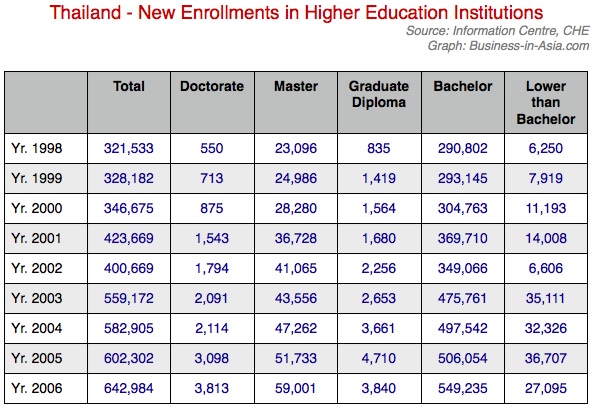
It should be noted above that the numbers of master’s degrees has
nearly tripled - from 23,096 in academic year 1998 to 59,001 in
academic year 2006. Doctoral students have also shown a dramatic
leap from 550 students in academic year 1998 to 3,813 in academic year
2006.
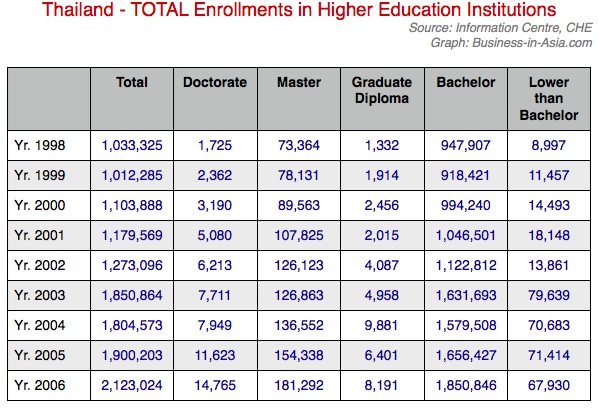
Total enrollments are also up substantially from 1,033,3256 in academic
year 1998 to 2,123,024 in academic year 2006. Further, total
enrollments for bachelor’s degree students rose from 947,907 in
academic year 1998 to nearly double in academic year 2006 with
1,850,846.
Total enrollment has not been the only increase, the number of
graduates has risen as well - from 108,903 in 1997 to 343,915 in
academic year 2005. Growth in all categories as seen in the chart
has been substantial.
There has also been increases in the number of international
students studying in Thailand according to information from the Bureau
of International Cooperation Strategy, Commission on Higher
Education.
The number of International students by Gender and by level of
education is shown in the two charts below.
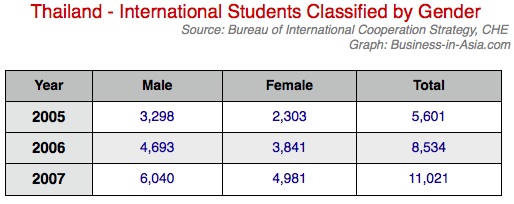
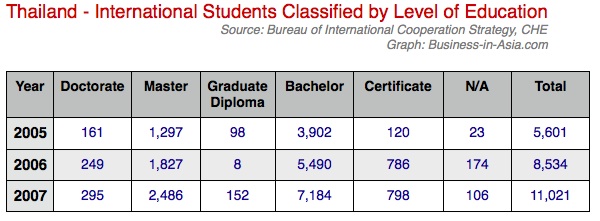
Assumption University, Mahidol and Chulalongkorn University have
continued to attract the majority of foreign students to
Thailand. The top ten ranking for the Institutions with the
highest level of international students are listed below for the three
years 2005, 2006 and 2007:
Most of the international students in Thailand come from surrounding
countries. China is has consistently sent the most
students. Please see figures below:
Business and business related subjects are the dominant subject of
study for international students studying in Thailand. Please see
chart below:
There were 6,350 Thai students studying abroad under government funded
programs according to the Civil Service Commission as of July 1,
2008. Of this total, there were 4,779 students on government
scholarships, 650 officials on study leave, 513 officials on training
programs and 408 on other sholarships. In terms of destination
for these studies, 24.8% studied in the U.S.; 20.3% studied in the U.K.
and 9.2% studied in Japan. Other major countries for study in
order of total students were France, Germany, Australia, China, the
Netherlands, Switzerland and Canada.
Major
Universities
Below is a list of some of the major Universities in Thailand:
- Chulalongkorn University: Founded in
1916 and with 18 faculties, three schools, three colleges and six
institutes and with a total enrollment of more than 32,500
undergraduate and graduate students, Chula as it is called in short is
one of Thailand’s premier Universities. In 2006, Chulalongkorn
University was ranked Excellent in both academics and research by the
Commission of Higher Education. It also has been top ranked Thai's
university for the past 4 years by the Times Higher Education - QS
World University Rankings. In 2008, it was ranked 72nd for Social
Science, 86th for Technology and 108th for Life Science &
Biomedicine.with a current total student enrollment of 26,381. Offers
bachelor’s, master’s and doctoral degrees.
- Thammasat University: The second oldest
University in Thailand was founded in 1934. Presently,
Thammasat University has over 30,000 students (25,000 undergradutes)
enrolled in 23 faculties, colleges and institutes: the faculties of
Law; Commerce and Accountancy; Political Science; Economics; Journalism
and Mass Communication; Liberal Arts; Social Administration; Sociology
and Anthropology; Science and Technology; Engineering; Medicine; Allied
Health Sciences; Public Health; Dentistry; Nursing; Architecture and
Planning; Fine and Applied Arts; the Sirindhorn International Institute
of Technology; the Language Institute; the College of Innovative
Education; the College of Inter-disciplinary
Studies; the Pridi Banomyong International College; and the Graduate
Volunteer Center.
- Mahidol University: Mahidol University
(MU) has its origins in the first institution of higher learning in
Thailand, namely the medical school founded at SIriraj Hospital in
1890. Later becoming the University of Medical Sciences in 1942, the
University was renamed in 1969 by H.M. King Bhumibol Adulyadej after
his own father, Prince Mahidol of Songkla, who is widely considered to
be the Father of Modern Medicine and Public Health in Thailand. Since
then, the university has expanded into a prestigious multi-disciplinary
university, covering numerous fields of discipline including medicine,
basic and applied sciences, public health, nursing, pharmacy,
dentistry, engineering, environment, veterinary sciences, sport
sciences, disability studies, management, hospitality industry,
religious studies, social sciences, music and the arts with a current
total student enrollment in excess of 30,000.
- Kasetsart University: Founded in 1943
with a current total student enrollment of 27,366 and located on 7
highly dispersed campuses. KSC offers bachelor’s, master’s and doctoral
degrees and is particularly known for programs in Agriculture, biology
and science plus offering a large number of other degrees.
- Silpakorn University: Founded in 1943
with a current total student enrollment of 7,339. Offers bachelor’s,
master’s and doctoral degrees. Well known in Thailand for
programs in the arts.
- King Mongkut Institute of Technology:
King Mongkut's Institute of Technology Ladkrabang (KMITL) is located in
Lat Krabang (approximately 30 kilometres east of the center of
Bangkok), and is a university with seven faculties: engineering,
architecture, agricultural technology, science, industrial education,
agricultural industry, and information technology. KMITL has been
recognized as one of the top science and technology universities in
Thailand. Three campuses established in 1959, 1960 and 1971.
Total student enrollment is 34,912. Offers bachelor’s, master’s and
doctoral degrees.
- Chiang Mai University: Since
opening in 1964, with the three founding Faculties of Science, Social
Sciences, and Humanities, CMU as it is called has continued to grow in
terms of premises, the range of disciplines offered, and student
enrollment. Today, CMU has seventeen Faculties with 107 individual
departments, and a Graduate School. CMU currently offers a total of 253
programs: 3 Certificate Programs, 87 undergraduate programs and 163
postgraduate and graduate diploma programs, to more than twenty-five
thousand students. In addition, two international Bachelors program and
18 international Masters and Doctoral programs, taught in English
language, are presently being offered to international students by
Social Sciences, Health Sciences, and Science and Technology faculties.
- Ramkamheng University: Founded
in 1971 and is the largest open University in the
country. At present, Ramkhamhaeng University offers
Bachelor’s Degree Programs, Master’s Degree Programs, Ph. D. Programs,
International Programs and Pre-degree Programs in 10 Faculties and the
Graduate School. In addition, the university also provides a wide range
of excellent academic and administrative support facilities, total of
18 Institutes/Offices /Centers. The total number of students enrolled
at Ramkhamhaeng University is approximately 430,000 each year,
consisting of nearly 400,000 undergraduate and 35,000 graduate students.
- Assumption University is the follow-on
organization from Assumption Commercial College which in 1969 became an
autonomous higher education institution under the name of Assumption
School of Business. In 1972, with the approval of the Ministry of
Education, it was officially established as Assumption Business
Administration College or ABAC. In May 1975, it was accredited by the
Ministry of University Affairs. In 1990, it was granted new status as
"Assumption University" by the Ministry of University Affairs.
The University is a non-profit
institution administered by the Brothers of St. Gabriel, a worldwide
Catholic religious order, founded in France in 1705 by St. Louis Marie
De Montfort, devoted to education and philanthropic activities. The
congregation has been operating many educational institutions in
Thailand since 1901. Assumption University is noted
in Thailand for attracting large numbers of foreign students from
countries including India, China, Myanmar, Pakistan, Bangladesh, Russia
and other Asian countries. Students from China make up the largest
number of foreign students, with up to 6,000 enrolled. Approximately
1,000 Indian students also attend the university.
Assumption University is also the first international university in
Thailand and currently has over 16,000 undergraduate students.
- Khon Kaen University: Founded in 1964,
Khon Kaen University (KKU) is the largest education and learning center
in the Northeast of Thailand. KKU currently hosts more than
29,000 students, learning within 17 faculties, covering almost every
discipline. A satellite campus is located in Nong Khai..
- National Institute of Development
Administration: Founded in 1966 and currently has 6,225 students.
Offers masters and doctoral degrees only.
- Prince of Songkla University: Prince of
Songkla University was the first university in Southern Thailand
and was established in 1967. and currently enrolls 15,033
students. Offers only bachelor’s and master’s degrees. The
university consists of four campuses and one education service area. In
1968, the first permanent campus was established in Pattani. The
campus in Hat Yai was opened in 1971 and is now the main campus, having
more than 50% of the university's students. Other campuses were
established in Phuket (1977) and Surat Thani (1990). Additionally,
Trang education service area was added in 1991. As of 2007, the
university offered 295 educational programs to its 34,000 students,
including 18 international programs and 3 foreign language programs.
- Srinakharinwirot University: Formerly a
teacher training school, upgraded to a university in 1974, and
currently enrolls 13,452 students. Offers bachelor’s, master’s and
doctoral degrees.
- Burapha University: Burapha
University is a public university located in Bangsaen, Chonburi, about
100 km. from Bangkok, in the Eastern Seaboard Area of Thailand. The
campus covers an area of 256 acres. It was first established as the
Bangsaen College of Education in 1955-the first tertiary education
institution ever established outside of Bangkok- to produce graduates
in teacher education. In 1984, when the Prasarnmitr College of
Education in Bangkok was upgraded to university level and named
Srinakharinwirot University, Bangsaen College of Education was included
as a branch campus and started to offer several other degrees besides
teacher education. In 1990, due to the need for more college-trained
personnel to implementation the Government'sEastern Seaboard
Development Project to industrialize the area, the Bangsaen
Campus was upgraded to full university level and renamed Burapha
University, which means "University of the East". Currently
Burapha hosts approximately 36,245 students (as of 2009), aided by 992
teaching staff and 300 general employees. The university offers degrees
in more than fifty programs of study, including 75 master's programs,
three Ed. D programs, and twenty Ph. D programs.
Private
universities in Thailand have been increasing quickly as noted earlier
Private universities come under the authority of the Private Higher
Education Institutions Division of the MUA, which must approve and
accredit new institutions. The largest private university is Bangkok
University with 25,000 students.
- The Rajamangala Institute of Technology
offers bachelor programs in technology and technical fields.
- The Rajabhat Institutes, formerly
teacher training colleges, and located in provinces throughout
Thailand, provide training in practical fields such as tourism
management and business administration.
- The Asian Institute of Technology (AIT),
formerly the SEATO Graduate School of Engineering, is the only
university that is not supervised by the Ministry of University
Affairs. AIT is a largely autonomous institution established under its
own charter. Only 20 percent of its funding is provided by the Thai
government and recently their has been some questioning of the
continued need for AIT. AIT enrolls students throughout the
Asia-Pacific region and boasts an international faculty.
About the
Author:
Christopher W. Runckel, a
former senior US diplomat who served in many counties in Asia, is a
graduate of the University of Oregon and Lewis and Clark Law School. He
served as Deputy General Counsel of President Gerald Ford’s
Presidential Clemency Board. Mr. Runckel is the principal and founder
of Runckel &
Associates, a Portland, Oregon
based consulting company that assists businesses expand business
opportunities in Asia. (www.business-in-asia.com)
Until April of 1999, Mr.
Runckel was Minister-Counselor of the US Embassy in Beijing, China. Mr.
Runckel lived and worked in Thailand for over six years. He was the
first permanently assigned U.S. diplomat to return to Vietnam after the
Vietnam War. In 1997, he was awarded the U.S. Department of States
highest award for service, the Distinguished Honor Award, for his
contribution to improving U.S.-Vietnam relations.
|





